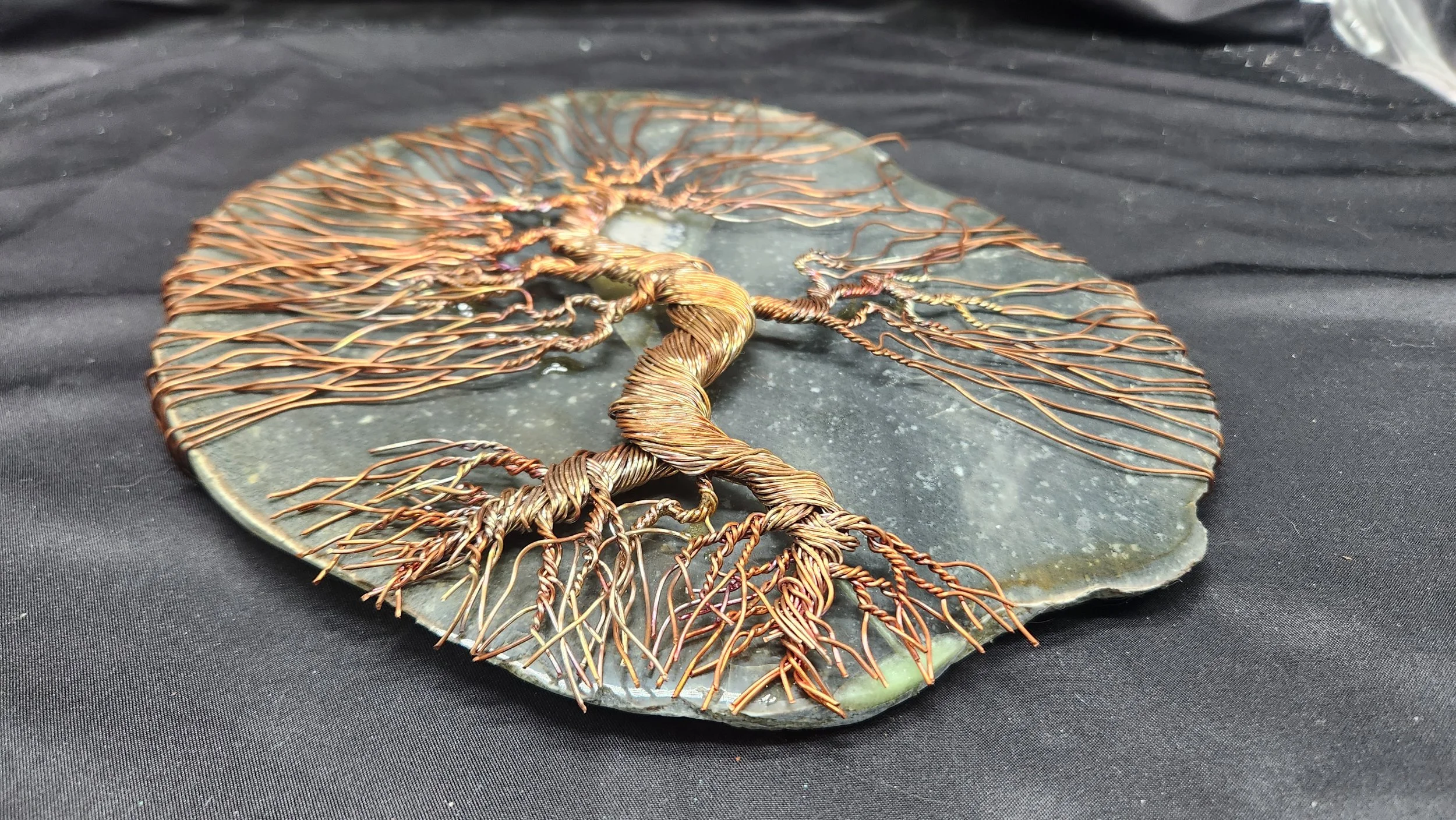 Image 1 of 4
Image 1 of 4

 Image 2 of 4
Image 2 of 4

 Image 3 of 4
Image 3 of 4

 Image 4 of 4
Image 4 of 4





#523 (Wall art)
I’ve never been much of a fan of those overused idioms, the kind you hear so often they lose their flavor — you know, like “The best defense is a good offense.” But there’s one classic phrase I genuinely adore, and that’s “When life gives you lemons, make lemonade.” This particular piece is crafted from the very same stone as my very first clock. This stone was far bigger than any tool in my arsenal at the time, which made slicing it completely through impossible and it ended up leaving a triangular post right in the center keeping my slice attached to the rest of the stone. Usually, a good pry bar would do the trick and pop that post easily, but this time? Nope. The slab split into three pieces, and a chunk was missing from the middle — lemons.
While I was no stranger to using epoxy to mend cracked slabs, and I’d even frequently use the ancient art of “Kintsugi” (see below), but this was way beyond just a cracked stone. It was a bona fide broken mess. Months passed before inspiration struck. I decided to set a small round stone right into the void and Kintsugi everything back together with epoxy. Still, even after all that, it just didn’t scream “clock” to me. So, the piece sat around, quietly waiting for its moment of brilliance.
And then came the accidental magic. I had made a traditional larger copper tree back in my wire tree-making days. Almost by chance, I plopped that tree right on top of the slab, and suddenly, it hit me — I didn’t have to be a slave to the clock form. This could be something else, a quirky and vibrant piece of wall art.
So here it is: my lemonade. Measuring 9.25 inches wide by 9.5 inches tall, featuring a shiny green stone flecked with white speckles, accented by a small light “moon” granite slice nestled in the center void. The swirling, pearl-colored epoxy flows through the cracks in true Kintsugi fashion, creating delicate veins that highlight the piece’s journey from rock to art. The large, pure copper tree with exposed roots is flame-painted to reveal its bright and colorful brilliance.
Kintsugi is the ancient Japanese art of repairing broken pottery by mending the areas of breakage with urushi lacquer dusted or mixed with powdered gold, silver, or platinum.
I’ve never been much of a fan of those overused idioms, the kind you hear so often they lose their flavor — you know, like “The best defense is a good offense.” But there’s one classic phrase I genuinely adore, and that’s “When life gives you lemons, make lemonade.” This particular piece is crafted from the very same stone as my very first clock. This stone was far bigger than any tool in my arsenal at the time, which made slicing it completely through impossible and it ended up leaving a triangular post right in the center keeping my slice attached to the rest of the stone. Usually, a good pry bar would do the trick and pop that post easily, but this time? Nope. The slab split into three pieces, and a chunk was missing from the middle — lemons.
While I was no stranger to using epoxy to mend cracked slabs, and I’d even frequently use the ancient art of “Kintsugi” (see below), but this was way beyond just a cracked stone. It was a bona fide broken mess. Months passed before inspiration struck. I decided to set a small round stone right into the void and Kintsugi everything back together with epoxy. Still, even after all that, it just didn’t scream “clock” to me. So, the piece sat around, quietly waiting for its moment of brilliance.
And then came the accidental magic. I had made a traditional larger copper tree back in my wire tree-making days. Almost by chance, I plopped that tree right on top of the slab, and suddenly, it hit me — I didn’t have to be a slave to the clock form. This could be something else, a quirky and vibrant piece of wall art.
So here it is: my lemonade. Measuring 9.25 inches wide by 9.5 inches tall, featuring a shiny green stone flecked with white speckles, accented by a small light “moon” granite slice nestled in the center void. The swirling, pearl-colored epoxy flows through the cracks in true Kintsugi fashion, creating delicate veins that highlight the piece’s journey from rock to art. The large, pure copper tree with exposed roots is flame-painted to reveal its bright and colorful brilliance.
Kintsugi is the ancient Japanese art of repairing broken pottery by mending the areas of breakage with urushi lacquer dusted or mixed with powdered gold, silver, or platinum.
